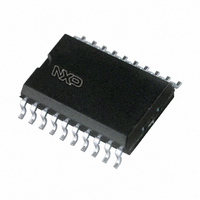TDA9801T/V1,118 NXP Semiconductors, TDA9801T/V1,118 Datasheet - Page 6

TDA9801T/V1,118
Manufacturer Part Number
TDA9801T/V1,118
Description
IC PLL DEMODULATOR 20-SOIC
Manufacturer
NXP Semiconductors
Datasheet
1.TDA9801V1112.pdf
(32 pages)
Specifications of TDA9801T/V1,118
Package / Case
20-SOIC (0.300", 7.50mm Width)
Function
Demodulator, Detector
Current - Supply
70mA
Voltage - Supply
4.5 V ~ 9.9 V
Mounting Style
SMD/SMT
Lead Free Status / RoHS Status
Lead free / RoHS Compliant
Gain
-
Noise Figure
-
P1db
-
Lo Frequency
-
Rf Frequency
-
Lead Free Status / RoHS Status
Lead free / RoHS Compliant, Lead free / RoHS Compliant
Other names
935260645118
TDA9801TD-T
TDA9801TD-T
TDA9801TD-T
TDA9801TD-T
Philips Semiconductors
FUNCTIONAL DESCRIPTION
3-stage IF amplifier
The VIF amplifier consists of three AC-coupled differential
amplifier stages (see Fig.1). Each differential stage
comprises a feedback network controlled by emitter
degeneration.
AGC detector, IF AGC and tuner AGC
The automatic control voltage to maintain the video output
signal at a constant level is generated in accordance with
the transmission standard. Since the TDA9801(T) is
suitable for negative modulation only the peak sync pulse
level is detected.
The AGC detector charges and discharges capacitor C
to set the IF amplifier and tuner gain. The voltage on
capacitor C
signal, and is fed to the tuner AGC to generate the tuner
AGC output current on pin TAGC (open-collector output).
The tuner AGC takeover point level is set at pin TOP. This
allows the tuner to be matched to the SAW filter in order to
achieve the optimum IF input level.
Frequency detector and phase detector
The VIF amplifier output signal is fed into a frequency
detector and into a phase detector. During acquisition the
frequency detector produces a DC current proportional to
the frequency difference between the input and the VCO
signal. After frequency lock-in the phase detector
produces a DC current proportional to the phase
difference between the VCO and the input signal. The DC
current of either frequency detector or phase detector is
converted into a DC voltage via the loop filter which
controls the VCO frequency.
Video demodulator
The true synchronous video demodulator is realized by a
linear multiplier which is designed for low distortion and
wide bandwidth. The vision IF input signal is multiplied with
the ‘in phase’ component of the VCO output.
The demodulator output signal is fed via an integrated
low-pass filter (f
harmonics to the video amplifier.
VCO, AFC detector and travelling wave divider
The VCO operates with a symmetrically connected
reference LC circuit, operating at the double vision carrier
frequency. Frequency control is performed by an internal
variable capacitor diode.
1999 Aug 26
Single standard VIF-PLL demodulator
and FM-PLL detector
AGC
is transferred to an internal IF control
g
= 12 MHz) for suppression of the carrier
AGC
6
The voltage to set the VCO frequency to the actual double
vision carrier frequency is also amplified and converted for
the AFC output current.
The VCO signal is divided-by-2 with a Travelling Wave
Divider (TWD) which generates two differential output
signals with a 90 degree phase difference independent of
the frequency.
Video amplifier
The composite video amplifier is a wide bandwidth
operational amplifier with internal feedback. A nominal
positive video signal of 1 V (p-p) is present at pin VSO.
Buffer amplifier and noise clipper
The input impedance of the 7 dB wideband CVBS buffer
amplifier (with internal feedback) is suitable for ceramic
sound trap filters. Pin CVBS provides a positive video
signal of 2 V (p-p). Noise clipping is provided internally.
Sound demodulation
L
The FM sound intercarrier signal is fed to pin SI and
through a limiter amplifier before it is demodulated.
The result is high sensitivity and AM suppression.
The limiter amplifier consists of 7 stages which are
internally AC-coupled in order to minimizing the DC offset.
FM-PLL
The FM-PLL demodulator consists of an RC oscillator,
loop filter and phase detector. The oscillator frequency is
locked on the FM intercarrier signal from the limiter
amplifier. As a result of this locking, the RC oscillator is
frequency modulated. The modulating voltage (AF signal)
is used to control the oscillator frequency. By this, the
FM-PLL operates as an FM demodulator.
AF
The audio frequency amplifier with internal feedback is
designed for high gain and high common-mode rejection.
The low-level AF signal output from the FM-PLL
demodulator is amplified and buffered in a low-ohmic
audio output stage. An external decoupling capacitor C
removes the DC voltage from the audio amplifier input.
By using the sound mute switch (pin MUTE) the AF
amplifier is set in the mute state.
IMITER AMPLIFIER
AMPLIFIER
DETECTOR
Product specification
TDA9801
DAF















